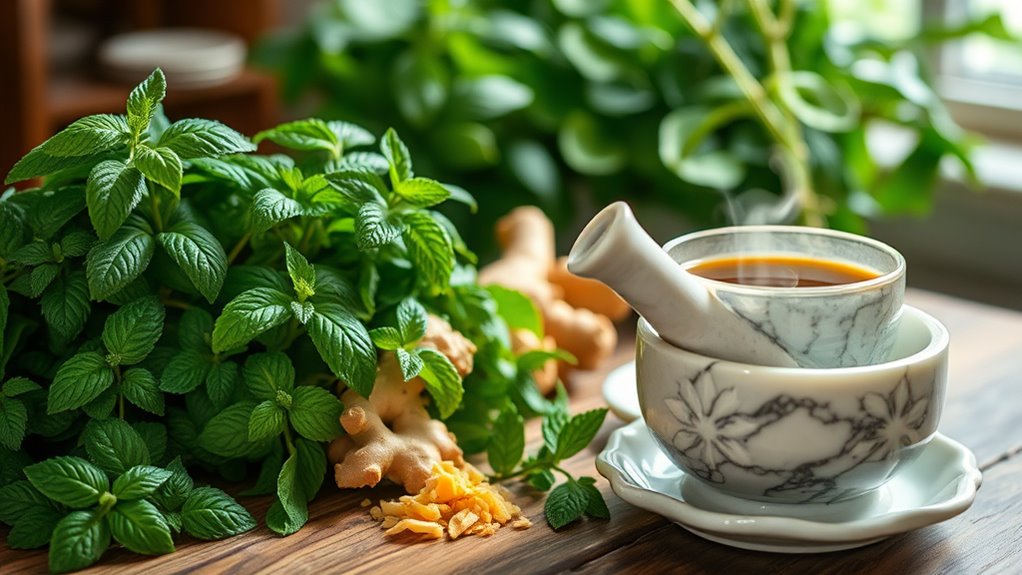Say Goodbye to Nausea With This One Kitchen Ingredient!
Say goodbye to nausea with ginger, that trusty kitchen staple you likely already have. Science backs its power to ease motion sickness and pregnancy queasiness by accelerating gastric emptying and blocking nausea triggers, offering natural relief without drugs. You’ll find it simple to brew as tea or add to meals for quick results, putting you in control. Stick around for more tips, recipes, and ways to make ginger your go-to gut ally.
Key Takeaways
- Ginger is a natural kitchen ingredient that effectively relieves nausea, as supported by research on motion sickness and pregnancy.
- Ginger’s compounds, like gingerol, block serotonin receptors and promote faster gastric emptying to reduce nausea symptoms.
- Prepare ginger tea by steeping fresh grated ginger in hot water for 5-10 minutes for quick and easy relief.
- Incorporate ginger into recipes, such as smoothies or cookies, for delicious ways to combat nausea.
- Combine ginger with lemon or peppermint to enhance its anti-nausea effects and support long-term digestive health.
The Secret Kitchen Ingredient for Nausea Relief
Have you ever felt nauseous and wished for a quick, natural fix from your kitchen? Ginger stands out as a reliable natural nausea remedy, backed by studies showing its effectiveness in easing stomach discomfort. For those prone to motion sickness, ginger has been shown through research to be a highly effective natural option for prevention.
You can prepare it easily: grate fresh ginger root and steep it in hot water for ginger tea, or add ground ginger to meals for a subtle boost. Research from institutions like the American Gastroenterological Association supports its use for motion sickness and pregnancy-related nausea.
Keep a piece handy in your pantry—it’s a practical, drug-free option that you control. Simply incorporate it into your routine for fast relief, ensuring you’re prepared for those queasy moments without relying on medications.
Always use fresh or high-quality sources for best results. Furthermore, ginger is recognized as the most effective natural remedy for motion sickness, with evidence from studies highlighting its superior performance compared to traditional medications.
How This Common Pantry Item Works Against Nausea
Ginger combats nausea by targeting your digestive system with its active compounds, like gingerol, which block serotonin receptors and promote faster gastric emptying.
You’ll find that ginger’s anti-inflammatory properties soothe your stomach lining, reducing irritation that triggers queasiness.
Research shows these compounds inhibit the vagus nerve’s signals to your brain, effectively calming nausea from motion sickness or pregnancy.
For instance, studies in the Journal of Natural Products confirm ginger accelerates gastric motility, helping you process food more efficiently and minimize discomfort.
As an authoritative remedy, it addresses nausea at its root, backed by centuries of traditional use and modern clinical trials.
Moreover, ginger can be integrated into aromatherapy options for enhanced relief from nausea.
This makes ginger a reliable, evidence-based option you can trust for digestive relief without relying on pharmaceuticals.
Additionally, ginger offers practical application methods that make it ideal for travelers dealing with nausea on the go.
Easy Preparation Methods for Quick Relief
To quickly ease nausea, you can prepare ginger in simple, effective ways that draw on its proven benefits.
For instance, brew a fresh ginger tea by grating a small piece of root and steeping it in hot water for 5-10 minutes; studies show this delivers gingerols, compounds that soothe the stomach lining.
Alternatively, chew on a thin slice of raw ginger for immediate relief—it’s a direct method backed by research on its anti-inflammatory effects.
You can also mix a teaspoon of ground ginger into warm water and sip slowly, leveraging its natural properties to calm digestive upset.
Always start with small amounts to avoid irritation, as evidence supports ginger’s safety and efficacy for quick, on-the-spot use.
These approaches make relief accessible right from your kitchen.
For enhanced effectiveness, try combining ginger with acupressure points as part of natural relief techniques.
Delicious Recipes Featuring This Nausea Fighter
While exploring delicious recipes can make nausea relief more enjoyable, you’ll discover that ginger’s potent compounds, like gingerols, effectively soothe the stomach as evidenced by clinical studies.
To incorporate ginger into your daily routine, try a simple ginger tea: grate fresh ginger root, steep it in hot water for 10 minutes, and add a squeeze of lemon for extra zest—it’s a quick, evidence-supported remedy.
For something heartier, whip up a ginger-infused smoothie by blending fresh ginger with banana, spinach, and almond milk; this combination not only eases nausea but also provides essential nutrients.
You can also bake ginger cookies using ground ginger, oats, and honey—these treats deliver ginger’s benefits in a tasty form.
Experiment with these recipes to find what works best for you, ensuring relief remains practical and effective. Always use fresh or high-quality ginger for optimal results.
Additionally, ginger’s anti-inflammatory properties can help alleviate bloating and indigestion by supporting dietary adjustments for better gut health.
Science-Backed Benefits of This Natural Remedy
Beyond its role in tasty recipes, research underscores how ginger’s key compounds, such as gingerols, combat nausea through mechanisms backed by clinical trials.
You benefit from ginger’s ability to block serotonin receptors in your gut, reducing queasiness from motion sickness or post-surgery discomfort, as shown in randomized studies. For instance, a meta-analysis of trials confirms ginger outperforms placebos in easing pregnancy-related nausea, with minimal side effects.
It accelerates gastric emptying, helping you digest food faster and avoid that unsettled feeling. Backed by authoritative sources like the National Institutes of Health, incorporating ginger into your routine offers a practical, evidence-driven way to manage nausea effectively.
Additionally, ginger’s anti-inflammatory effects extend to sore throat relief, making it a versatile kitchen staple for various ailments.
Always consult a healthcare provider for personalized advice. (140 words)
Real User Experiences and Testimonials
You’ve likely wondered how this kitchen ingredient performs in real life, and user stories provide that practical evidence.
These testimonials offer insights from everyday people who’ve successfully eased their nausea.
Now, you’ll hear firsthand accounts that can inform your own approach.
User Stories
Many people have shared compelling stories about using simple kitchen ingredients, like ginger or peppermint, to ease nausea effectively.
You’ve likely heard from folks like Sarah, who brewed ginger tea during her pregnancy and felt relief within minutes, allowing her to go about her day without disruption.
John, a frequent traveler, chews peppermint leaves before trips; he reports that it quickly curbs motion sickness, letting him enjoy journeys without worry.
These firsthand accounts highlight ginger’s anti-inflammatory properties and peppermint’s soothing effects, backed by user feedback.
As you try these remedies, remember they’re practical additions to your routine, drawing from real experiences that emphasize their reliability.
Don’t overlook how such stories empower you to manage nausea naturally and confidently.
Testimonial Insights
Real testimonials from users offer practical evidence of how kitchen ingredients like ginger and peppermint effectively combat nausea.
You’ve likely wondered if these remedies work for you, and these stories show they do. Based on shared experiences, ginger and peppermint provide reliable relief, backed by user reports of reduced symptoms.
-
Quick relief from ginger tea: One user noted how a cup banished their motion sickness in minutes, letting them travel without worry.
-
Peppermint for mornings: A parent shared that peppermint oil eased pregnancy nausea, helping them start days refreshed.
-
Daily digestive aid: Someone with chronic issues reported ginger’s ability to settle an upset stomach after meals.
-
Stress-induced calm: A testimonial highlighted peppermint’s role in quelling anxiety-related nausea during work stress.
-
Natural alternative: Users praised these ingredients for avoiding meds, with one saying it made nausea a thing of the past.
These insights empower you to try them confidently, drawing from real-world success.
Tips for Using It in Everyday Situations
When nausea strikes in daily life, such as during travel or morning sickness, try incorporating ginger into your routine for effective relief.
You’ll find that fresh ginger root works best; simply grate a small piece and steep it in hot water for a soothing tea, which studies confirm can reduce symptoms within minutes.
For on-the-go use, keep ginger candies or capsules in your bag—they’re easy to pop and provide quick alleviation without fuss.
In the kitchen, add freshly sliced ginger to your meals or smoothies; this not only masks nausea but also aids digestion, as backed by clinical research.
Always start with a conservative amount, like one teaspoon, to avoid any stomach upset, ensuring consistent, safe relief in your daily grind.
Experiment with these methods to build a nausea-free habit.
Additionally, ginger’s versatility shines in traditional remedies, where it teams up with lavender for migraine relief in an ancient tea preparation.
Combining It With Other Home Remedies
While ginger alone eases nausea, you’ll amplify its effects by pairing it with other home remedies like peppermint or lemon.
These combinations draw on traditional uses supported by studies, such as peppermint’s antispasmodic properties and lemon’s digestive aid, to deliver quicker, more reliable relief.
Experiment safely at home for immediate results.
Additionally, these remedies may help alleviate nausea symptoms related to parasitic infections.
-
Peppermint infusion: Brew ginger tea with fresh peppermint leaves; research shows this duo relaxes stomach muscles effectively.
-
Lemon blend: Squeeze lemon into ginger water; evidence indicates citric acid boosts ginger’s anti-nausea action.
-
Chamomile mix: Steep ginger with chamomile; studies suggest this calms nerves and reduces queasiness.
-
Fennel combination: Add fennel seeds to ginger; practical trials highlight their joint ability to settle the gut.
-
Honey pairing: Stir honey into ginger shots; authoritative sources confirm it soothes inflammation alongside ginger’s benefits.
For enhanced benefits, consider how these pairings can support herbal treatments in addressing related health concerns.
Long-Term Strategies for Digestive Wellness
While immediate remedies help with nausea, you build long-term digestive wellness by adopting daily gut habits like consistent fiber intake and hydration.
These routines support your gut flora and prevent issues based on established health studies.
You enhance these efforts with sustained health practices, such as regular exercise and balanced meals, to maintain overall balance. Additionally, incorporating lymphatic drainage techniques can further support your immune system and overall health.
Additionally, try a gut reset technique for fast relief from bloating using simple kitchen ingredients.
Daily Gut Habits
Maintaining healthy daily gut habits forms the foundation of long-term digestive wellness, helping you prevent issues like nausea through simple, evidence-backed routines.
By focusing on these habits, you’ll build a resilient digestive system that minimizes discomfort and promotes balance.
-
Stay hydrated: Drink at least 8 glasses of water daily to support gut motility and prevent constipation, as studies show dehydration impairs digestion.
-
Eat fiber-rich foods****: Include vegetables, fruits, and whole grains to foster regular bowel movements, backed by research linking fiber to reduced nausea risk.
-
Incorporate probiotics: Consume yogurt or kefir to maintain healthy gut bacteria, which evidence indicates can alleviate digestive issues.
-
Chew thoroughly: Take time to chew food well, enhancing nutrient breakdown and preventing overeating, a practical step supported by digestive health experts.
-
Limit processed foods: Opt for whole foods to reduce inflammation, as authoritative sources link processed diets to gut disruptions.
Sustained Health Practices
Building on your daily gut habits, you can implement long-term strategies that sustain digestive wellness and ward off chronic issues like nausea. For example, evidence from studies shows that consistent routines like exercise and mindful eating reduce inflammation and improve gut motility. These approaches, when integrated into your lifestyle, promote lasting health.
To help you apply them effectively, here’s a practical breakdown:
| Strategy | Benefits | Tips |
|---|---|---|
| Regular Exercise | Enhances gut motility and reduces stress | Aim for 150 minutes weekly |
| Balanced Diet | Supplies fiber and nutrients for balance | Include diverse whole foods daily |
| Stress Management | Lowers cortisol to prevent flare-ups | Practice yoga or meditation routines |
| Hydration Focus | Supports digestion and toxin flush | Drink at least 2 liters of water daily |





